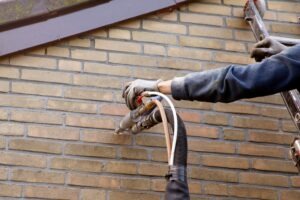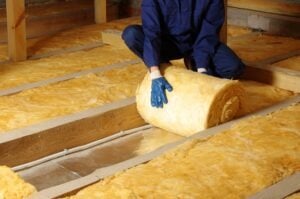- Home
- About Us
- Member Profiles
- Help and Advice
arrow_drop_down
- Conciliation
arrow_drop_down
- Guild magazine
The Cost of Home Insulation
 The government’s recent announcement that it will freeze energy bills until 2024 has come as a huge relief to many UK households who were fearing a bleak financial winter ahead. But if you’re amongst the households still facing bills of £2,500 a year on average, understanding the cost of home insulation and ways to cut your energy consumption could be at the top of your to-do list.
The government’s recent announcement that it will freeze energy bills until 2024 has come as a huge relief to many UK households who were fearing a bleak financial winter ahead. But if you’re amongst the households still facing bills of £2,500 a year on average, understanding the cost of home insulation and ways to cut your energy consumption could be at the top of your to-do list.
However, the benefits of insulation aren’t just about long-term savings on energy bills. Cutting carbon emissions and bumping up your property’s EPC certificate – This is now compulsory for all properties sold if you are considering selling your home in the near-future.
According to website The Eco Experts, approximately two-thirds of homes are rated a D or below in their Energy Performance Certificate (EPC), due to high carbon emissions and steep energy bills, both can be reduced significantly by effective insulation.
Home insulation on any budget
Whatever your budget, the good news is that there are a wide range of insulation options for your home. And while you can roll up your sleeves and tackle some basic insulation techniques yourself, plus employ some clever tricks – see DIY Heating Hacks below – the bigger undertakings, such as insulation foam installation, should be carried out by a professional.
While the initial outlay might see your own temperature rising, it’s worth it to avoid costly mistakes. This is where we can help. At Find a Craftsman, our job is to help you find recommended insulation installers who will deliver the best service within your budget. Just click here
to choose from our hundreds of skilled tradesmen across the UK.
This findacraftsman.com guide breaks down the fundamental insulation methods and costs. Let’s dive in.
Wall insulation
An estimated one third of escaping heat in an uninsulated home occurs through the walls. If you have cavity walls, a professional will inject insulation foam into the space in the wall, usually outside, before sealing up the entry holes with cement. When mixed together, chemicals isocyanate and polyol resin create an expanding foam that increases in volume by up to 30–60 times.
There are two types of spray foam insulation, closed cell, which does not allow air to pass through it, and open cell, which has a breathable quality to it, making it more of an expensive option. Most experts agree the foam should be a minimum thickness of 760mm within walls.
According to Which?, spray foam insulation costs £20–£50 per square metre, depending on the thickness used. The Which? table below outlines costs using 100mm-thick spray foam.

Property type | Average property size (m2) | Average cost |
House | 97.5 | £3,412.50 |
Flat | 41.5 | £1,452.50 |
Maisonette | 78.5 | £2,747.50 |
You should also remember to factor in daily tradesmen rates of around £150–£200 a day and be prepared for further expenses, such as electrical wire relocation. Again, you can click here to find a skilled electrician in your area. It’s also crucial that the installation is covered by a 25-year guarantee and our tradesmen will offer that peace of mind along with high levels of professionalism. Checking that they belong to an accredited association, such as the National Insulation Association (NIA) or the Cavity Insulation Guarantee Agency (CIGA), is also strongly recommended
How long will it take to recoup your wall insulation investment?
Based on the figures above, it will take between three and nine years to break even, and as the energy prices rise this will only be quicker. You’re looking at 8.9 years to see a return on a house, for example. It might be worth looking at whether you are eligible for financial support through the ECO4 scheme and remember that you are helping the planet too. Governmentbusiness.co.uk suggests a semi-detached home fitted with solid wall insulation (see below) can save up to two tonnes of carbon per year.
Solid wall insulation
For solid walls, even though the cost of insulation materials – typically rolls of fibreglass – is relatively cheap, stud walls on internal walls and plasterwork or cladding on external walls are used to sandwich the fibreglass, quickly pushing prices upwards. Mineral wool, an alternative to fibreglass, offers a slightly higher thermal performance, greater sound reduction and better protection against fire, but will add further costs.
According to the Energy Saving Trust, internal solid wall insulation for a semi-detached house will come with a price tag of around £8,200 but could save you around £255 a year on your energy bills. This being possibly a very costly investment in these challenging times.
 Attic/loft insulation
Attic/loft insulation
Insulating your loft or attic is the equivalent of popping a hat on to stop heat escaping from your head. The Energy Saving Trust claims that 25% of our home heat is lost through an uninsulated roof. Which? states that loft insulation can reduce your energy bills by up to £315 annually, depending on the size of your home.
Loft insulation typically costs around £20 for a 100mm-thick roll, which can cover 8.3m², with a recommended total thickness of 270mm. Of course, it is perfectly possible to tackle this project yourself, following good YouTube instruction videos. A top tip is not to squash the insulation blanket because this significantly reduces its efficiency.
However, if there are damp and condensation issues – common in this area of a home – and if the space is tricky to access or there are fiddly joists to work around, the best advice is to get the professionals in.
Installed correctly, loft insulation offers a quick return on investment, paying for itself several times over in its 40-year lifetime, so it’s worth getting it right. The Energy Trust says that a typical semi-detached house’s energy bills will be reduced by around £165 a year, with a carbon footprint reduction of approximately 580kg a year.
Flat roof insulation
To comply with building regulations, all new flat roofs must now be insulated. It’s possible to insulate an existing flat roof from underneath but be warned that if you choose to do this yourself, you run the risk of condensation issues if not completed correctly.
One of our professional tradesmen will advise the best approach is to insulate from above, where a layer of rigid insulation board is added either on top of the roof’s weatherproof layer or directly on top of the timber roof surface, with a new weatherproof layer on top of the insulation.
 Types of roof insulation
Types of roof insulation
There are several types of insulation materials you can choose from. These include:
- Blanket insulation
- Loose-fill insulation
- Sheet insulation
- Spray-foam insulation
You can use this guide from the Homeowner Costs website to compare the different costs based on your insulation type. This is a handy baseline for when you receive quotations from your selected tradesmen on Find a Craftsman.
Approximate costs for a four-bedroom home with a 75m2 loft area
Insulation type | Estimated cost |
Fibreglass blanket (3 layers) @ £8/m2 | £600 |
Loose-fill @ £9/m2 | £675 |
Sheet @ £30/m2 | £2,250 |
Spray-foam @ £35/m2 | £2,625 |
DIY Heating Hacks
Foiled!
Although former Tory MP Edwina Currie, appearing on Good Morning Britain, was mocked for her suggestion of putting tin foil behind radiators in the face of the energy crisis, she was on to something. You can use regular tinfoil or inexpensive special foil, available from DIY chains, to reflect heat back into the room instead of it escaping through poorly insulated walls.
Floored!
Underfloor heating out of your financial reach? Wool rugs – unlike synthetic choices – have fantastic insulative properties. Scattering wool rugs over a hardwood or tiled floor will keep the cold out and the cosy underfoot feeling in.
Capture the Sun!
Capitalise on free solar energy during the winter months by strategic use of your curtains and thermal blinds. South or West facing windows (ideally double-glazed) will absorb the most heat during the day, passively warming your home. Just make sure to close your curtains at dusk to seal in the warmth.
Don’t forget the conservatory…
Use furnishings such as draught excluders for doors and heavy lined curtains or thermal blinds. You might want to consider specialist glass films to further reduce levels of escaping heat.
The Guild of Master Craftsmen is the UK’s most established trade association, proudly representing tradespeople and artisans who have skill, integrity and expertise for over 40 years. There are hundreds of reliable, trustworthy and experienced contractors at your fingertips at Find a Craftsman for all of your tradespeople needs.

